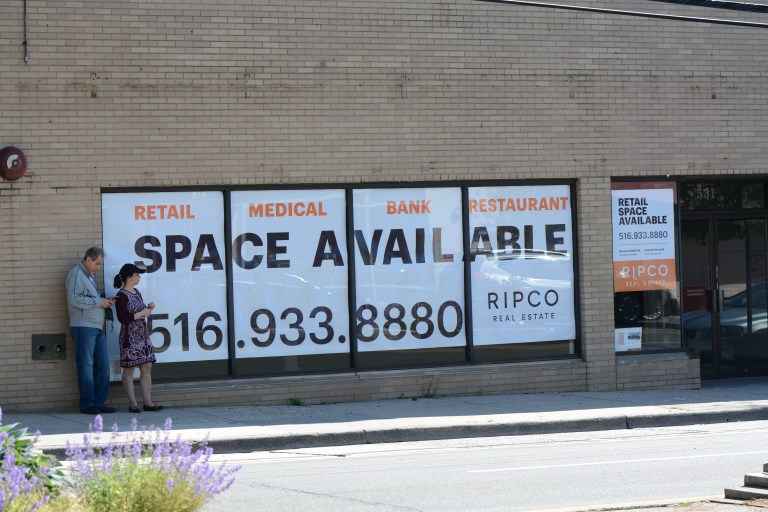
When the owners of a bakery left a Greenvale shopping center, an antiques seller took over the lease. He had no plans to modify the structure, just to move in his mosaics and candelabra and start business.
But after signing the lease, there was about half a year of back and forth between the landlord and the Town of North Hempstead before the store was given all its permits. To this day, leaseholder Scott Defrin said, he does not have permission to put up a second exterior sign.
Business owners and brokers on Long Island say one thing makes this area a uniquely difficult place to open a business: bureaucracy.
Between the number of distinct municipalities one can find in a 10-mile radius and the procedures for legally opening a brick and mortar business, making it to the ribbon cutting can be a nightmare, business owners say.
Opening in Greenvale was an endlessly frustrating process, said Defrin, who moved his antique store from Manhattan. There were three different safety inspections, aspects that kept coming back as noncompliant and periods of waiting.
“I was losing patience,” he said. “I wanted to open up, I wanted to be legal and it just seemed like they were sort of stretching the rubber band to the point where it was sort of unnecessary.”
To open a business, entrepreneurs need building department approval, either from a village if the area is incorporated or the local town if it isn’t. Should the project require an exception to be made, it heads to the planning department in search of variances. About 5 percent of projects in the Town of North Hempstead do, said town Planning Commissioner Michael Levine.
In total, the town budgeted $4.375 million in building permit revenue for 2019, which helps fund the department itself, Levine said. Aggregate fees for businesses going through the permitting process typically run from $3,000 to $5,000, Levine said.
But the need for architects and other contractors can bring simple projects up to tens of thousands of dollars, said broker Bradley Diamond, a principal at Great Neck’s Lee & Associates office.
Defrin’s application required plans demonstrating that the physical space would remain the same, in turn requiring an architect. The architect essentially drew what already existed, Defrin said.
The system can be a deterrent for business owners to venture into the area in the first place, Diamond said.
“People have to have the money and the financial stamina to wait six to eight months to up to a year for the permitting process,” he said.
The number of local jurisdictions provides an extra challenge for chains seeking to open more than one location on Long Island, Levine said.
“You want to go through identical processes, but every zoning jurisdiction has a completely different way of doing essentially the same thing,” he said.
Many of the permits local towns and village require are for safety measures regulated by the state.
New York determines requirements for sprinkler systems and fire extinguishers, for example, which municipalities then enforce.
“The Building Department does not make decisions as to if something’s a smart idea or are they personally in favor,” Levine said. “They are purely code-compliant, so if you comply with the code, you get the permit.”
Code compliance came into Roslyn Village Veterinarian owner Dr. Mario Vezza’s life after a car crashed into his building. While he shifted his operation to a temporary trailer, he began planning to repair and expand the building, but not his client capacity.
His business had seven parking spaces. It only hosts up to three clients at a time, Daniel Winkelman of VHB Engineering told the Roslyn Zoning Board of Appeals at a January hearing, according to the minutes.
With an expansion that would approximately double its square footage, village code required it to have 22. Though Vezza planned to expand parking to 12 spaces, the remaining 10-space difference required a variance.
As per village code, he was charged $2,000 for each of the 10 missing spaces.
One solution for the business community, Diamond and Levine said, would be to have a single zoning code for Long Island similar to how New York City operates. That, however, is a very distant and unlikely goal, they both said.
Perhaps building departments could start by prioritizing new developments, or village boards could meet more frequently than once a month if they’re receiving applications, Diamond said.
Levine said that over the course of his 24 years as planning commissioner he has gained the ability to influence the Town Board when he sees a need for a change in code. The board annually revises the code to modernize outdated requirements, he said.
“The process is streamlined where you can, but if something’s taking a while because of a heavy backload that’s not really a legislative fix,” Levine said.
In a time where physical establishments are competing with internet-based operations, extra hurdles in opening are the opposite of what is needed, Diamond said.
“It’s very frustrating and frustrating because it’s so hard to find somebody who actually wants to open up a business in today’s climate,” Diamond said. “Then they have to wait for months and months and months. Who wants to do it?”







We are going through the same process with the Town of North Hempstead. It’s been 18 months and counting and we are still not open. It’s infuriating.